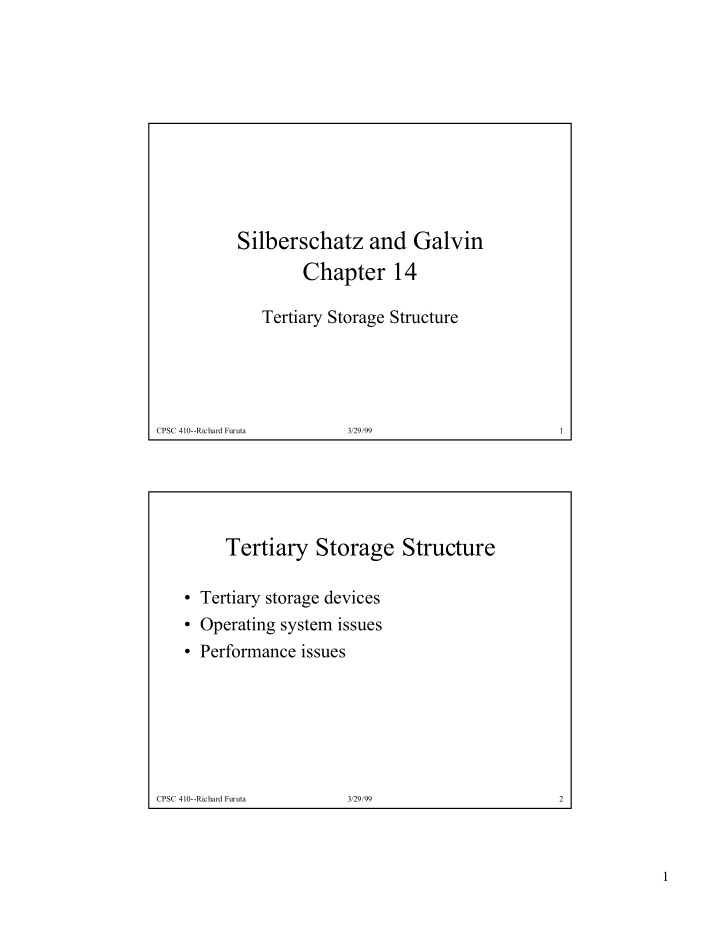



Silberschatz and Galvin Chapter 14 Tertiary Storage Structure CPSC 410--Richard Furuta 3/29/99 1 Tertiary Storage Structure ¥ Tertiary storage devices ¥ Operating system issues ¥ Performance issues CPSC 410--Richard Furuta 3/29/99 2 1
Tertiary Storage Devices ¥ Defining characteristic: low cost ¥ Generally built using removable media ¥ Examples: floppy disks, CD-ROM, É Ð Floppy disks: thin flexible disk coated with magnetic material, enclosed in a protective plastic case Ð Optical disks: materials that are altered by laser light to have spots that are relatively light and dark ¥ Phase-change disk: crystalline or amorphous state ¥ Dye-polymer disk: laser heat makes bumps, warms bumps to remove them CPSC 410--Richard Furuta 3/29/99 3 Magneto-optic disk ¥ Magnetic material covered with protective layer of plastic or glass; head much farther from disk than with magnetic disk; less susceptible to head crashes ¥ Laser heat makes spot susceptible to magnetic field (records) ¥ Laser light polarization when bouncing off of magnetic spot used for reading (Kerr effect) CPSC 410--Richard Furuta 3/29/99 4 2
Removable disks ¥ Read-write disks Ð Magnetic disks, magneto-optic disks, optical disks ¥ Write-once, read many (WORM) Ð One example: thin aluminum film sandwiched between two glass or plastic platters; holes burnt through aluminum; information can be destroyed but not altered Ð Another example: CD-R ¥ Read-only disks Ð Examples: CD-ROM and DVD CPSC 410--Richard Furuta 3/29/99 5 Robotic jukebox for Magneto- optical disks CPSC 410--Richard Furuta 3/29/99 6 3
CPSC 410--Richard Furuta 3/29/99 7 Magnetic tape ¥ Compared to disk: Ð Less expensive, holds more data, random access much slower Ð Robotic tape installations ¥ Stacker: library that holds a few tapes ¥ Silo: library that holds thousands of tapes Ð Archive disk resident tapes for low-cost storage. Stage back into disk storage for active use CPSC 410--Richard Furuta 3/29/99 8 4
Magnetic tape ¥ Tape silo at Jefferson Lab (http://www.jlab.org/ccc/silo/info/) Ð One terabyte of data a day received Ð 6000 tapes Ð 50 gigabytes per tape at present Ð 300 terabytes total storage Ð Expected enhancements up to over a petabyte (1,000 terabytes) of Ònear-lineÓ storage CPSC 410--Richard Furuta 3/29/99 9 CPSC 410--Richard Furuta 3/29/99 10 5
CPSC 410--Richard Furuta 3/29/99 11 CPSC 410--Richard Furuta 3/29/99 12 6
Operating System Issues ¥ Major OS jobs Ð Manage physical devices Ð Present a virtual machine abstraction to applications ¥ Hard disk abstractions Ð Raw device: an array of data blocks Ð File system: OS queues and schedules the interleaved requests from several applications CPSC 410--Richard Furuta 3/29/99 13 Application interface ¥ Most OSs handle removable disks almost exactly like fixed disks--a new cartridge is formatted and an empty file system is generated on the disk. ¥ Tapes: raw device. Application opens whole tape drive rather than file on tape. Ð Tape drive reserved for exclusive use of application Ð Application decides how to use the array of blocks Ð TapeÕs format is generally specific to the program that created it CPSC 410--Richard Furuta 3/29/99 14 7
Tape drives ¥ Basic operations for tape drives differ from those of a disk drive ¥ Locate : position tape to specific logical block (instead of seek ) Ð Locate 0 is the same as rewinding ¥ Read position : current logical block ¥ Space : relative movement over logical blocks Ð Space -2: go back two logical blocks ¥ Append-only devices. Update effectively erases everything past that block ¥ EOT mark follows last block on tape CPSC 410--Richard Furuta 3/29/99 15 Speed ¥ Tertiary storage aspects of speed: bandwidth and latency ¥ Bandwidth: measured in bytes per second Ð Sustained bandwidth --average data rate during a large transfer; number of bytes/transfer time (this is the data rate when the data stream is actually flowing) Ð Effective bandwidth --average over the entire I/O time, including seek or locate , and cartridge switching (this is the driveÕs overall data rate) CPSC 410--Richard Furuta 3/29/99 16 8
Speed ¥ Access latency--amount of time needed to locate data Ð Access time for a disk--move the arm to the selected cylinder and wait for the rotational latency; generally less than 35 milliseconds Ð Access time on tape requires winding tape reels until the selected block reaches the tape head; tens or hundreds of seconds. Ð Generally say that random access within a tape cartridge is about a thousand times slower than random access on disk. ¥ Access times on jukebox or tape silo (robotic arm) also requires time to remove (including possibly a return to a consistent state), locate, and load media. Hence removable library best for infrequently used data. CPSC 410--Richard Furuta 3/29/99 17 Reliability ¥ Fixed disk drive is likely to be more reliable than removable disk or tape drive ¥ Optical cartridge is likely to be more reliable than a magnetic disk or tape ¥ Head crash in a fixed hard disk generally destroys the data whereas the failure of a tape drive or optical disk drive often leaves the data cartridge unharmed ¥ Recently, much controversy over lifetimes of CD-ROM Ð Manufactured CD-ROMs versus CD-R (predictions in both directions) Ð Years or decades? CPSC 410--Richard Furuta 3/29/99 18 9
Cost ¥ Main memory is much more expensive than disk storage ¥ The cost per megabyte of hard disk storage is competitive with magnetic tape if only one tape is used per drive ¥ The cheapest tape drives and the cheapest disk drives have had about the same storage capacity over the years ¥ Tertiary storage gives a cost savings only when the number of cartridges is considerably larger than the number of drives CPSC 410--Richard Furuta 3/29/99 19 10
Recommend
More recommend